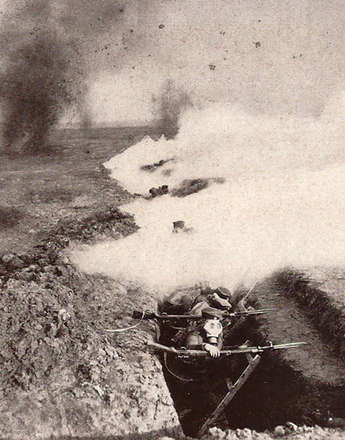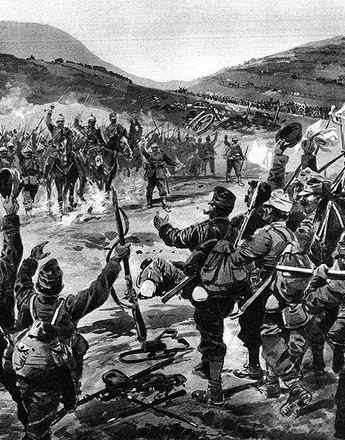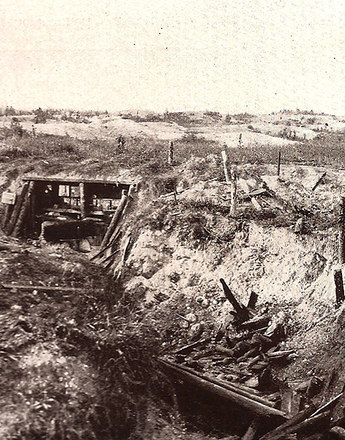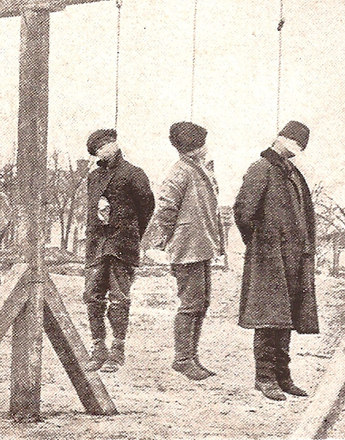-
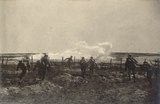
Attack in Eastern Galicia, photograph
Copyright: Heeresgeschichtliches Museum, Wien
Partner: Museum of Military History -

Serbian withdrawal road, photograph, 1916
Copyright: Heeresgeschichtliches Museum, Wien
Partner: Museum of Military History -

Speech by Emperor Franz Joseph to the benefit of the Imperial-Royal Austrian Military Widows and Orphans Fund, sound recording, 14 December 1915
Copyright: Österreichische Mediathek
Partner: Österreichische Mediathek -

-

Overview map of the theatre of war in the west, contemporary map
Copyright: Privat
When the grim reality of the war became clear, Kaiser Wilhelm’s hearty promise that the war would end in a German victory by the autumn of 1914 – ‘when the leaves fall’ – was still fresh in all minds. In the first two years of the war, the Central Powers experienced both successes and also failures.
In the first months of the war the German army enjoyed successes on the Western Front, where German units overran Belgium and launched a massive offensive on France. At first the French army went onto the defensive and it seemed that the Germans had a good chance of taking Paris.
Then, however, the French army recovered from its initial state of shock and the German advance ground to a halt, its offensive being brought to an end by the ‘miracle on the Marne’. November 1914 saw the establishment of a front line and the initial offensive mutated into a war of entrenchment with only negligible advances being made after enormous loss of human life and expenditure of material. The trenches of northern France became a symbol of the industrialized war machinery and the mass slaughter that went with it.
In the East the Austro-Hungarian army met with serious resistance in Serbia. Although the challenges of the invasion had initially been downplayed with predictions that the campaign would be no more than a ‘little excursion’, the defending forces’ better knowledge of the terrain and higher morale turned it into an embarrassment for Austria, with the army’s commanders earning no laurels at all for its disproportionately brutal treatment of the civilian population. Only with the help of German and Bulgarian units – Bulgaria having entered the Austro-German alliance in autumn 1915 – did they succeed in taking Serbia’s core territories.
The Austrian army was confronted with even greater difficulties in its Russian offensive, being forced to retreat and engage in a humiliating rearguard battle. The Habsburg Monarchy lost significant parts of Galicia, which they only recovered in 1915 when the German army succeeded in repulsing Russian attacks and penetrating far into Russian territory. Although the summer of 1917 saw the Central Powers in control of the Baltic area and Russian Poland, the enormous length of the front – 1600 kilometres – put a massive burden on Germany and the Danube Monarchy.
The situation was further complicated by the entry of Rumania into the war on the side of the Entente in 1916. Although this opened up yet another theatre of war, the Central Powers succeeded in bringing Rumania under their control by the end of 1916, after which the overall situation in the Balkans was to remain relatively stable until the end of the war.
Translation: Peter John Nicholson
Bihl, Wolfdieter: Der Erste Weltkrieg 1914–1918. Chronik – Daten – Fakten, Wien/Köln/Weimar 2010
Hamann, Brigitte: Der Erste Weltkrieg. Wahrheit und Lüge in Bildern und Texten, 2. Aufl., München 2009
Hanisch, Ernst: Der lange Schatten des Staates. Österreichische Gesellschaftsgeschichte im 20. Jahrhundert [Österreichische Geschichte 1890–1990, hrsg. von Herwig Wolfram], Wien 2005
Hirschfeld, Gerhard/Krumeich, Gerd/Renz, Irina (Hrsg.): Enzyklopädie Erster Weltkrieg. Aktualisierte und erweiterte Studienausgabe, Paderborn/Wien [u.a.] 2009
Leidinger Hannes/Moritz, Verena: Der Erste Weltkrieg, Wien [u.a.] 2011
Rauchensteiner, Manfried: Der Erste Weltkrieg und das Ende der Habsburgermonarchie 1914–1918, Wien u. a. 2013
-
Chapters
- The enthusiasm for the war
- ‘Brothers in arms’: Austria-Hungary and Germany as partners and allies
- Front lines – The course of the war 1914–16
- Italy enters the war
- The impact of the war on civilian society
- The accession of Emperor Karl
- The Sixtus Letters – Karl’s quest for a way out
- Karl’s bid for freedom
- The Russian Revolution and its consequences
- 1917 – The turning point


